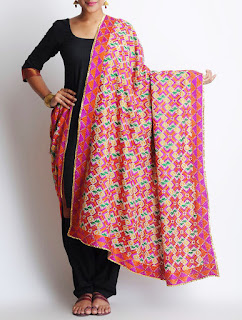Phulkari Embroidery craft from the Punjab region literally means flower work. The word 'Phul' means flower and 'Kari' means craft, thus the word 'Phulkari' literally means floral work or floral craft. Phulkari is the most famous rural embroidery tradition of Punjab, mentioned in the Punjabi folklore of Heer Ranjha. Its present form and popularity goes back to the 15th century, during Maharaja Ranjit Singh’s reign. Its distinctive property is that the base is a dull hand-spun or Khadi cloth, with bright coloured threads that cover it completely with embroidery, leaving no gaps. Famous places for Phulkari Embroidery work are the cities of Amritsar, Jalandhar, Ambala, Ludhiana, Nabha, Jind, Faridkot, and Kapurthala. Beautiful Hand Embroidered Phulkari Dupattas of Punjab on Amazon USA  |
| Phulkari Embroidery Duppatta of Punjab, India |
 |
| Phulkari Embroidery Duppatta of Punjab, India |
 |
| Phulkari Embroidery Duppatta of Punjab, India |
 |
| Phulkari Embroidery Duppatta of Punjab, India |
 |
| Phulkari Embroidery Duppatta of Punjab, India |
 |
| Phulkari Embroidery Duppatta of Punjab, India |
 |
| Phulkari Embroidery Duppatta of Punjab, India |
 |
| Phulkari Embroidery Duppatta of Punjab, India |
 |
| Phulkari Embroidery Duppatta of Punjab, India |
 |
| Phulkari Embroidery Duppatta of Punjab, India |
 |
| Phulkari Embroidery Duppatta of Punjab, India |
 |
| Phulkari Embroidery Duppatta of Punjab, India |
 |
| Phulkari Embroidery Duppatta of Punjab, India |
 |
| Phulkari Embroidery Duppatta of Punjab, India |
 |
| Phulkari Embroidery Duppatta of Punjab, India |
 |
| Phulkari Embroidery Duppatta of Punjab, India |
 |
| Phulkari Embroidery Duppatta of Punjab, India |
 |
| Phulkari Embroidery Duppatta of Punjab, India |
 |
| Phulkari Embroidery Duppatta of Punjab, India |
Beautiful Hand Embroidered Phulkari Dupattas of Punjab on Amazon USA
Simple and sparsely embroidered Odini (head scarfs), Dupatta and shawls made for everyday use, were called Phulkaris once, whereas garments that cover the entire body, made for special and ceremonial occasions like weddings etc, were called Baghs (Garden), and the scattered work on the fabric was called 'Aadha Bagh' (Half Garden).
Phulkaris Embroidery, as already mentioned, is done with floss silk thread on coarse hand woven cotton fabric. Geometrical patterns are usually embroidered on the Phulkaris. Phulkaris and Baghs were once worn by women all over Punjab during marriages, festivals and other joyous occasions. They were embroidered by family women for their own use, and for the use of other family members, and were not for sale in the market once upon a time, as it is today. Thus, it was purely a domestic art which not only satisfied the inner urge of women for creative work, but also brought colour into day-to-day life. In a way, it was a true folk-art.
The most favoured colour in Phulkari is red and its different shades, as Bagh and Phulkari are used mostly during marriage and other festive occassions. Red is considered auspicious by Hindus and Sikhs. Other colours are brown, blue, black, white. White was used in Bagh by elderly ladies. Silk thread in strands for embroidery came from Kashmir, Afghanistan and Bengal.
Traditionally, Phulkari garments were part of a girl's wedding trousseau. Its motifs were expressive of her emotions and the number of Phulkari pieces in marriages defined the status of the family. Over the years, government has been working towards promotion of Phulkari Embroidery, by organizing special training programs, fairs, and exhibitions. Since most of the women artisans creating Phulkari were in the unorganized sector, they were not making much money compared to the actual market price of their product. But with the involvement of the government, the situation is improving these days.
Phulkari has been awarded the Geographical Indication (GI) status in India.
( Disclaimer : All images featured in this Blog-post, are the property of their respective owners. Our deepest sense of gratitude to all of them for making this gigantic project a reality. If you see your picture anywhere in this Blog and don't want it here, send us a message with the details and the link to the picture, and we will remove it right away. But at the outset, I just want to let my dearest readers know, that the noble purpose of this Blog, is to promote 'The Glorious Cultural Heritage of India' worldwide, to every nook & corner of the planet, and I would immensely love to see every single one of us, of Indian origin, passionately participating in this Mega-Project. I am right now in the process of adding the web-links to the sources of the innumerable images in this Blog. Till the work reaches completion, I would request the readers to use 'Google Image Search' to trace the source / multiple sources of these images on the web. The rich text contents througout this blog are based on well-researched aggregated and curated content from innumerable sources. But mostly and most importantly, these contents are based on my own personal experience of untiringly exploring the glorious cultural heritage India, and the ageless timeless ethnic arts, crafts, textiles, temples etc of the whole of India, during my stay across the length and breadth of this vast expansive Indian subcontinent for more than 5 decades of my long adventurous life. I have expressed my deepest gratitude to all the text sources on the 'World-Wide-Web', that have hugely contributed and added to my existing database of knowledge on this subject, by inserting appropriate hyperlinks throughout this blog, to connect my ardent readers from across the globe, to these rich sources of information on India's heritage. So Long, Mala Chandrashekhar )






















0 Comments